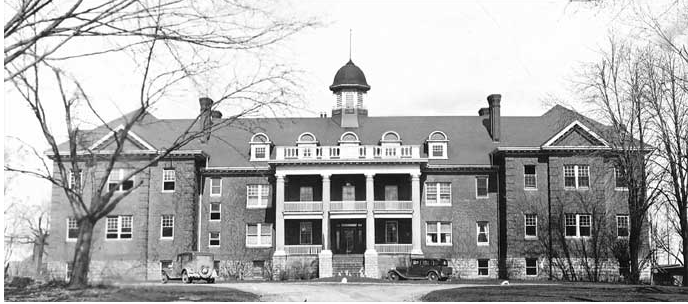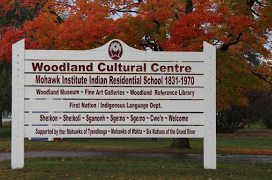Community foundations on the path towards Reconciliation

This month Community Foundations of Canada is sharing stories, ideas and examples of Reconciliation in action to highlight the many ways community philanthropy is involved in strengthening the relationship between Indigenous and non-Indigenous peoples, while building a stronger, more inclusive country.
Locally, visitors to the Mohawk Institute are giving back to campaign to keep former Brantford residential school standing.
MOHAWK INSTITUTE
The abuse that took place in the name of cultural assimilation at the Mohawk Institute Indian Residential School over many years remained hidden for decades.
Some wanted it to stay that way, but it took a courageous community to face the dark past of what should have been a place of learning to drag it into the light, with great hope the lessons learned will stop such atrocities from ever happening again in Canada.
Never has the spotlight been so bright as it has over the past year on the nationwide effort that dates back more than 130 years to systematically cleanse Canada of its native culture. And a substantial part of the light shining on the issue comes from Woodland Cultural Centre.
In a few shorts years, the Save the Evidence campaign has grown from an effort to fix the Mohawk Institute’s roof to a public awareness campaign that has hit Canadians hard with the profound realizations of what happened at many of the 139 residential schools across Canada.
About 10,000 people tour the school, which closed in 1970, each year.
“People who tour the school don’t want the tour to end the way it ends,” said education co-ordinator Lorrie Gallant. “They want it to end with something hopeful, but I can’t give them that.”
Gallant said it’s up to each person who becomes educated about the horrors of the residential schools during a tour to take that knowledge and contribute to what has become known as Canada’s truth and reconciliation.
“People have to ask themselves, ‘What am I going to do to help deliver this knowledge? They need to use their own gifts to create what reconciliation is to them. I can’t tell them what it is,” Gallant said.
The history of the residential school system has become part of school curriculums. Grade 5 classes frequently schedule tours of the Mohawk Institute. After taking the tour, classes often choose the simple yet important gesture of holding a fundraiser to help the Save the Evidence campaign as a form of reconciliation.
Part of outreach co-ordinator Jessica Powless’ job is to help these grassroots efforts in any way she can, whether it be supplying them with pamphlets to hand out at sales or a logo for flyers.
Gallant said it’s not unusual for people to have strong emotional reactions to the stories of abuse they hear while touring the former school. Many shed tears and need to sit down in the “reflections room” where they can be calmed by burning sweet grass, a traditional remedy. Some – often survivors of the schools or family members of survivors – faint on the tours.
“Many just can’t believe this happened in their community,” Gallant said. “Some survivors can’t get past the front steps.”
In 2013, the Woodland Cultural Centre set up a community consultation with the people of Six Nations of the Grand River to find out what they wanted to do with the Mohawk Institute. Despite being a place of widespread abuse where native children were punished for speaking their indigenous language or practising longstanding traditions, 98 per cent of Six Nations residents voted to save the building.
The goal has become to preserve it as a reminder of the past and create an educational tool so society does not repeat the horrifying acts the building hid for so long.
Former Mohawk Institute resident Douglas George Kanentiio of Akwesasne supports the Save the Evidence campaign.
“I believe the (Mohawk) Institute should be preserved as a memorial,” he said. “My wife and I visited Buchenwald when we were in Germany which is, with the exception of the rat-infested inmate barracks, left just as it was when liberated by the Russians in 1945. When anyone connected with the residential school reconciliation process brings this issue up I tell them to go to the institute and stay there for a couple of nights. Sleep in our bunk beds, eat our food, listen to the floors creak and the slow walk of the night watchman as he makes his rounds from the basement to the upper floors. This takes it from being an intellectual exercise to actual appreciating our circumstances.”
And so, the custodians of the Mohawk Institute next door at the Woodland Cultural Centre launched the Save the Evidence campaign in March 2014 to make sure the building didn’t collapse and fade into history. The campaign started out as a fundraiser to fix the roof, which had suffered extensive water damage. Woodland Cultural Centre executive director (and Brant Community Foundation board member) Janis Monture said the leaky roof was the catalyst to start the decision-making process.
Six Nations elected council was the first group to donate, pledging $220,000 towards the $1.5-million goal of the first phase, which aims to fix the roof or risk losing the entire building.
Donations to match the council have since come from the City of Brantford, as well as provincial government funding of $1.4 million from the Ministry of Tourism, Culture and Sport, $220,000 from the Ministry of Aboriginal Affairs and $35,000 from the Rotary Club of Brantford-Sunrise. Six Nations has given $20,000 from an economic development fund towards the projects and council has approved a second $50,000 round of funding for 2017.
Ontario Premier Kathleen Wynne offered an apology from the provincial government for the residential school system in May 2016 along with the funding for the Mohawk Institute.
In April, former premier Bob Rae was named honorary patron of the Save the Evidence campaign.
Monture said Save the Evidence is about $2.2 million along on its way toward the ultimate goal of raising $10.5 million.
Another $2.5 million is needed for mechanical repairs. The balance, $6.5 million, will preserve the building’s history and establish interpretive elements for a museum.

